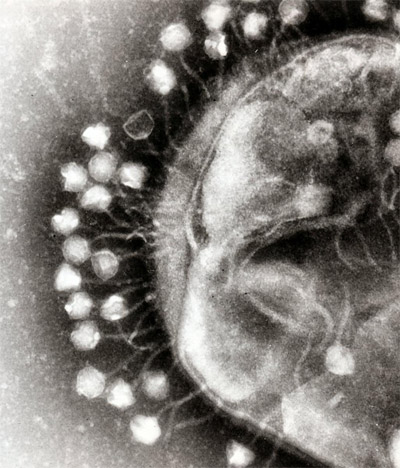(
Weizmann Institute of Science)
It may come as a bit of a surprise to learn that bacteria have an immune system - in their case to fight off invasive viruses called phages. And like any immune system, the first challenge of the bacterial immune system is to detect the difference between "foreign" and “self." This is far from simple, as viruses, bacteria and all other living things are made of DNA and proteins. A group of researchers at the Weizmann Institute of Science and Tel Aviv University has now revealed exactly how bacteria do this. Their results were published online today in
Nature.
“In most environments, phages are around ten times more abundant than bacteria. And, like all viruses, phages use the host cell's replication machinery to make copies of themselves," says
Prof. Rotem Sorek of the Weizmann Institute's Molecular Genetics Department. “They are constantly evolving new ways to do this. So bacteria need a very active immune system to survive."
 Phage Copyright: Weizmann Institute of Science
Phage Copyright: Weizmann Institute of ScienceSeveral years ago a bacterial adaptive system called CRISPR was discovered. The CRISPR immune mechanism is not just crucial to the bacteria, it has a major impact on our daily lives: It is used today, for example, to protect the “good" bacteria that make yogurt and cheese. And it may also affect our future: Scientists have figured out how to use the ingenious CRISPR system to “edit" the human genome - making it a handy tool for a wide range of clinical applications.
To remember an infection, the CRISPR system grabs a short sequence from the invading viral DNA and inserts it straight into the bacterial genome. The bits of phage DNA are stored in special sections of the genome which form the immune memory. Protein complexes attached to the RNA then identify the phage DNA and destroy it.
Selectivity is clearly an issue for such a system: Previous research in Sorek's lab had shown that mistakenly grabbing bits of self-DNA can cause the bacterial cell to suffer a sort of autoimmune disease in which it attacks its own DNA, and the results may be fatal to the bacteria. With around 100 times more self- than foreign DNA inside the cell, says Sorek, there would seem to be room for many more mistakes than researchers have actually observed.
How does the CRISPR system know how to insert foreign, rather than self, bits of DNA into the immune memory? Sorek and his research student Asaf Levy teamed up with Prof. Udi Qimron and Moran Goren of Tel Aviv University to answer the question in detail, revealing a complex, multi-step mechanism for this part of the CRISPR process.
They devised an experimental setup using plasmids - short, circular pieces of DNA that mimic viruses - and injected them into bacteria cells. The CRISPR system successfully incorporated the plasmid DNA into the bacterial genome, while the “self" DNA was only rarely attacked. The team recorded some 38 million separate immunization events. Looking more closely at the results, the team found that
the CRISPR system specifically identifies DNA that replicates rapidly. Thus, ironically, it is the phage's survival tactic - its programmed drive to replicate at all costs - that proves to be its downfall. “Still," says Sorek, “this did not completely explain how the CRISPR system differentiates between self and non-self."
The solution came from deeper understanding of the process. During DNA replication, small breaks occur frequently in the DNA; these breaks call up a DNA repair enzyme that “nibbles" a bit of the broken DNA. The team discovered that the “leftovers" from the repair machinery's nibbling are actually the source of the viral DNA used by the CRISPR system to generate the bacterium's immune memory. But when that repair enzyme meets a short sequence called a “Chi site," its nibbling stops. Such Chi sequences are found very frequently throughout the bacterial genome, but rarely in the viral one. So Chi sites also serve as “self" markers: They reject the activity of the CRISPR machinery when they are present, but enable it to use bits of phage DNA if they are missing.
Thus the bacterial cell uses its normal DNA replication and repair processes to identify phage DNA, checking and double-checking that the new DNA differs in two fundamental ways from the “self" genome. Through the activity of the two CRISPR proteins - Cas1 and 2 - the bacterial immune system can ensure it is adding foreign DNA, alone, to its immune “memory," and can thus activate its defenses.
Sorek: “Solving the riddle of self versus non-self for the bacterial immune system and deciphering the exact mechanism of this step in the CRISPR process gives us important insight into the unseen confrontation that is taking place everywhere, all around us, all the time." Qimron: “The bacterial solution to evading autoimmunity might be utilized in future clinical applications that take advantage of the CRISPR system."
Dr. Rotem Sorek's research is supported by the Dana and Yossie Hollander Center for Structural Proteomics; the Abisch Frenkel Foundation for the Promotion of Life Sciences; the European Research Council; the Leona M. and Harry B. Helmsley Charitable Trust; the Hugo and Valerie Ramniceanu Foundation; the Dr. Dvora and Haim Teitelbaum Endowment Fund; Mr. Martin Kushner Schnur in honor of Fanny Kushner; and the estate of Samuel and Alwyn J. Weber.